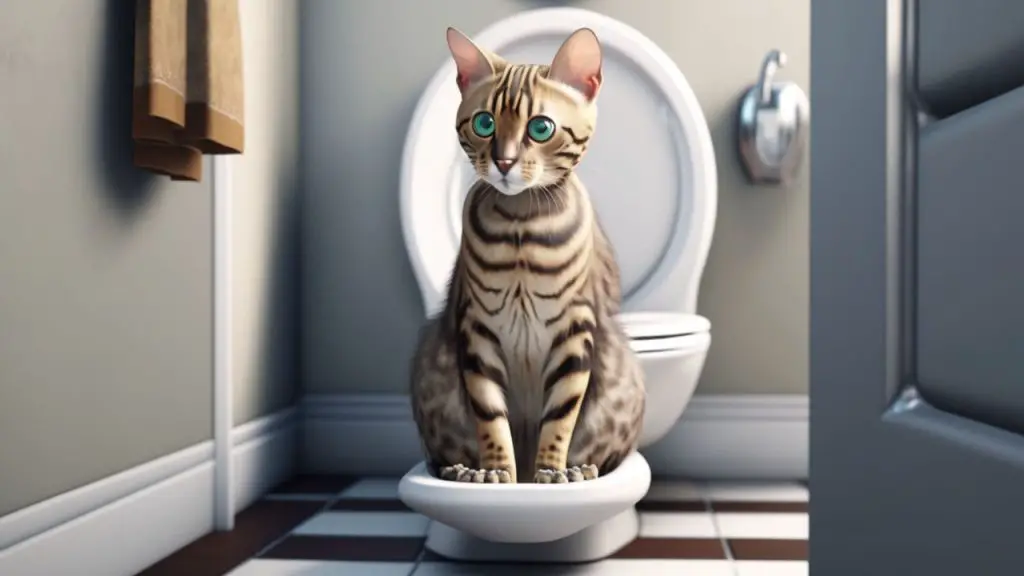Struggling to teach your Bengal cat to use the toilet? No need to worry! It’s simpler than you think! Follow these steps to train your pet and keep your home neat. You’ll be amazed by how fast they will adapt!
- Start by placing the litter box near the toilet.
- Encourage your cat to use the litter box by placing treats or toys near it.
- Gradually move the litter box closer to the toilet.
- Once the litter box is close enough, place a ramp or steps leading up to the toilet.
- Put the litter box on top of the toilet, and gradually reduce the amount of litter in the box.
- Finally, remove the litter box completely and reward your cat for using the toilet.
Training your Bengal cat to use a toilet can be great. It’s possible with patience and consistency. Even cats of any age or breed can learn this new routine.
This guide outlines the steps for toilet training a Bengal cat. It includes advice on the right bathroom space, transitioning from the litter box, and full flushing into a toilet system. Following the steps gradually will bring lasting rewards!
- Advice on the right bathroom space
- Transitioning from the litter box
- Full flushing into a toilet system
Choosing the Right Bathroom
Selecting a bathroom for potty-training your Bengal cat? Opt for one that has low traffic. It should be a tiny room with no disruptions and easy entry. Think of the number of people using it, door position, noise levels, and ventilation. Guard any electric wires or other items that could hurt your cat during training.
When you find the right one, move all supplies there so you have everything in one spot, all the way through potty training:
- Supplies
Moving the Litter Box to the Bathroom
Choose a bathroom for your cat. Move their litter box there slowly. Cats prefer routine and familiarity.
- Get an appropriate flushable kitty litter.
- Research what’s best for your plumbing system.
- Move the litter box bit by bit onto the toilet bowl.
- Make sure cats feel safe.
- It usually takes four weeks for cats to get used to the new spot. Give yourself enough time.
Switching to a Flushable Kitty Litter
When toilet-training your cat, switch to a flushable kitty litter. Regular clumping litters won’t work – they’ll expand when they come in contact with water and cause blockages.
Look for eco-friendly litter that starts small and clumps up when wet. It will break down quickly after flushing and help you avoid plumbing issues.
Choose a litter made from natural materials like ground grasses or shredded newspapers. They have lower dust levels than clay or silica-based litter. They’re better for your cat’s health and the environment.
Starting to Raise Up the Litter Box
Once you’ve shifted the litter box to the bathroom, you can start raising it up. This should take a few weeks. Put a low stool or other support beneath the box and increase its height every few days. If your Bengal cat appears hesitant or uneasy, slow down and give them more time. Speak to them gently and reward them for their progress. This will make them feel safe enough to use the toilet.
Moving the Litter Box onto the Toilet
Once your cat is comfy with the raised litter box, and you’ve switched to flushable kitty litter, it’s time to move the litter box to the toilet. Do it slowly so your cat can get used to their new environment. You’ll need a covered litter box, with adjustable sides or a training seat.
First, put the training seat on the toilet and make it part of their routine. With lots of positive reinforcement, they’ll become comfortable. Gradually raise the training seat until they’re using the adult-sized toilet with only the cover down. Go slow – cats can get overwhelmed and frustrated.
It may take multiple attempts, but if you show patience and reward your Bengals, they’ll master this skill!
Switching to a Training Seat
Switching to a training seat is the final move for toilet-training success with your cat. Training seats are made to sit over a toilet rim, giving your pet comfort and a feeling of safety while they adjust to the new surface.
Different kinds of training seats are on offer. Get one with a non-slip material and a locking system that’s easy to use. Put it on an open part of the toilet and secure it in place, leaving room for your cat’s tail to move freely. If you have multiple cats, buy a seat for each one so they have private space when they use the human toilet.
When it’s time to switch your cat from the litter box to its new seat, begin by raising the litter box up so it’s level with its training seat. Increase the height of the box a little each day, until it’s sitting securely on its perch. With patience and rewards, you’ll soon be able to get rid of the litter box!
Conclusion
Toilet training your Bengal cat? Patience is a must! It won’t happen in a single night. Don’t rush your cat! Commit to a step-by-step approach and remain consistent. This way, you’ll be successful in no time! With time and dedication, you can have a tidy kitty who’ll use the toilet instead of the litter box!







